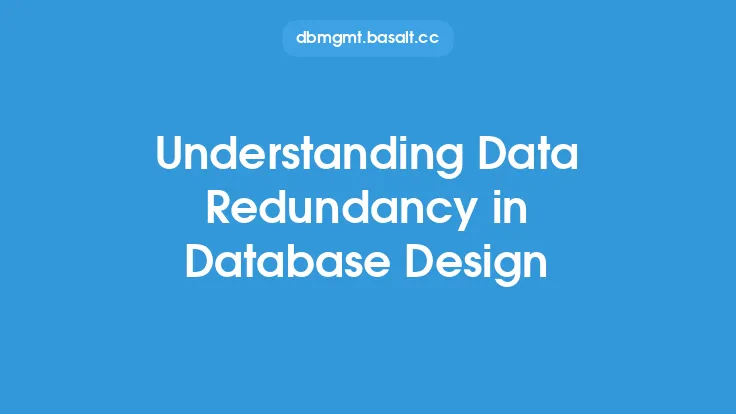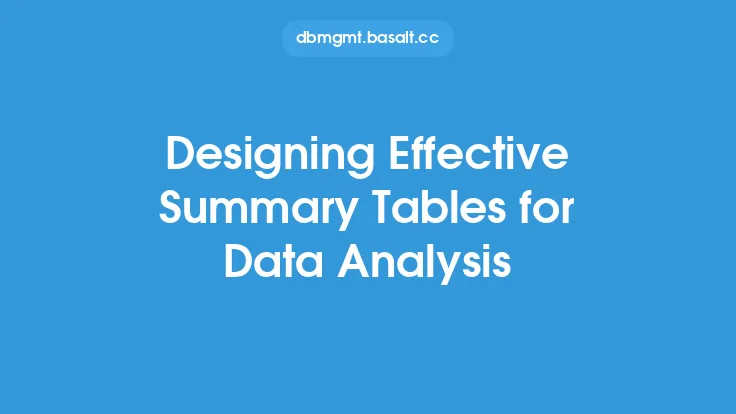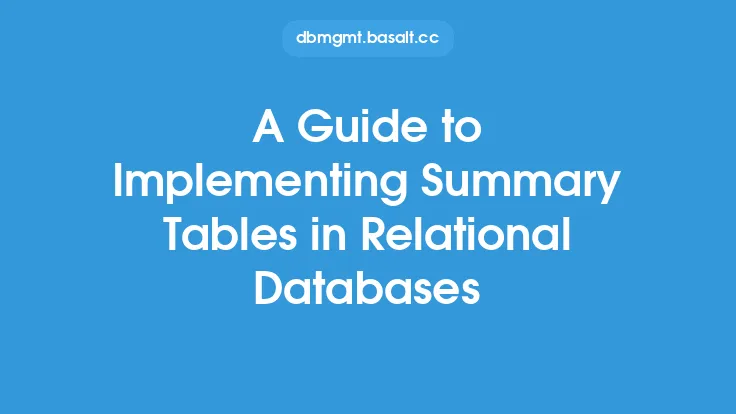In the realm of database design, the pursuit of optimal performance and data accessibility often leads to the implementation of various techniques. One such technique is the use of summary tables, which falls under the broader category of data denormalization. Data denormalization involves intentionally deviating from the principles of normalization to improve the performance of a database, particularly in scenarios where read operations far outnumber write operations. Summary tables are a specific application of this concept, designed to enhance query performance by pre-aggregating data.
Introduction to Summary Tables
Summary tables are pre-computed tables that store aggregated data, which can be used to speed up query execution. They are particularly useful in databases where certain queries are executed frequently, and these queries involve complex aggregations or joins. By storing the results of these aggregations in a separate table, the database can quickly retrieve the required information without having to perform the aggregation operations in real-time. This approach can significantly reduce the computational load on the database server, leading to improved performance and faster query execution times.
How Summary Tables Work
The process of creating and utilizing summary tables involves several key steps. First, the database designer must identify the queries that would benefit from the use of summary tables. This typically involves analyzing query logs and performance metrics to determine which queries are executed most frequently and which ones consume the most resources. Once the target queries are identified, the next step is to design the summary table. This involves determining the columns that should be included in the summary table, as well as the aggregation level. For example, a summary table might store the total sales by region, or the average order value by customer segment.
Design Considerations for Summary Tables
Designing effective summary tables requires careful consideration of several factors. One of the most critical factors is the granularity of the data. The summary table should store data at a level of granularity that balances the need for detailed information with the need for fast query performance. If the data is too granular, the summary table may become too large and unwieldy, defeating the purpose of improved performance. On the other hand, if the data is not granular enough, the summary table may not provide sufficient detail to support the required queries.
Maintaining Summary Tables
Another important consideration is how the summary table will be maintained. Since the summary table stores pre-aggregated data, it must be updated whenever the underlying data changes. This can be achieved through various mechanisms, such as triggers, scheduled jobs, or even manual updates. The choice of maintenance mechanism depends on the specific requirements of the database and the frequency of updates. For example, in a database where data is updated in real-time, triggers may be the best option. In contrast, in a database where data is updated periodically, scheduled jobs may be more appropriate.
Technical Implementation of Summary Tables
From a technical standpoint, implementing summary tables involves creating a new table with the desired structure and then populating it with the aggregated data. This can be done using SQL statements, such as CREATE TABLE and INSERT INTO. For example, to create a summary table that stores the total sales by region, the following SQL statement might be used:
CREATE TABLE sales_summary (
region VARCHAR(50),
total_sales DECIMAL(10, 2)
);
INSERT INTO sales_summary (region, total_sales)
SELECT region, SUM(sales_amount)
FROM sales_data
GROUP BY region;
This statement creates a new table called `sales_summary` with two columns: `region` and `total_sales`. It then populates this table with the aggregated data from the `sales_data` table, grouping the results by region.
Benefits and Trade-Offs of Summary Tables
The use of summary tables offers several benefits, including improved query performance, reduced computational load, and faster data retrieval. However, it also involves some trade-offs. For example, summary tables require additional storage space, which can be a concern in databases where storage is limited. Additionally, maintaining summary tables can add complexity to the database design and require additional resources. Furthermore, summary tables can become outdated if not properly maintained, leading to inaccurate results.
Conclusion
In conclusion, summary tables are a powerful technique in database design that can significantly improve query performance and data accessibility. By pre-aggregating data and storing it in a separate table, databases can reduce the computational load and provide faster query execution times. However, designing and implementing effective summary tables requires careful consideration of several factors, including data granularity, maintenance mechanisms, and technical implementation. As with any database design technique, the use of summary tables involves trade-offs, and database designers must weigh the benefits against the potential drawbacks to determine whether summary tables are appropriate for their specific use case.





